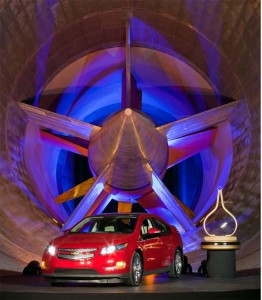
The 2011 Chevrolet Volt is shown at the GM wind tunnel - along with the Motor Trend Car of the Year trophy.
The trophy wars are just getting underway, but the 2011 Chevrolet Volt has already landed two key victories, winning the high-profile designation of Motor Trend Car of the Year, as well as the Car of the Year award from rival Automobile magazine.
The awards are the latest kudos for General Motors plug-in hybrid, and help overcome some of the stigma that arose shortly after Volt formal launch, last month, when GM officials acknowledged they had misled the media about the technology used to drive the battery-based vehicle.
Originally billed as an “extended-range electric vehicle,” or E-REV, which always uses electric power to drive its wheels, it turns out that the Chevy Volt occasionally relies on a direct mechanical assist from its backup 1.4-liter gasoline engine. Nonetheless, Motor Trend editors declared the 2011 model one of the most significant vehicles ever tested during the 61-year history of the magazine’s influential Car of the Year award.
“The Volt has some of the most advanced engineering ever seen on an American production car,” declared MT Editor Angus McKenzie. The magazine also suggested that while it originally expected “a science experiment,” the 2011 Chevrolet Volt was more like “a moon shot.”
Formal production of the Volt has just begun, with sales beginning before year-end. Originally intended to deliver 40 miles on a charge of its 16 kilowatt-hours of lithium-ion batteries, Chevy has since revised its forecast, offering a range of 25 to 50 miles.
That reflects the fact that battery-powered vehicles are sensitive to a variety of environmental and personal driving factors. An aggressive driver, stuck in Michigan traffic on a cold day, will likely see battery range drop to the lower factor, while someone cruising through the exurbs of Los Angeles, with minimal traffic and the climate control turned off, could get 50 miles.
Once the battery runs down, Volt is designed to keep running, unlike a pure battery-electric vehicle, the 1.4-liter I4 engine taking over. The controversy arose over an engineering decision to let the internal combustion engine connect directly to the driveline under some demanding conditions, rather than solely act as an electric generator.
Nonetheless, reviews of the Volt – including those on TheDetroitBureau.com (Click Here to read) have been almost universally enthusiastic.
While there were a number of key competitors considered for the Motor Trend and Automobile magazine awards, the most likely alternative was considered to be another new battery-based vehicle, the pure electric-powered 2011 Nissan Leaf.
Though GM and Nissan have insisted they are not direct competitors, each targeting a somewhat different kind of buyer, company insiders have occasionally taken shots at each other’s approach. But they’ve also acknowledged that it’s in the industry’s best interest for both products to succeed if consumers are to begin accepting the nascent battery-electric offerings.
By some counts, there could be as many as three dozen plug-in hybrids, E-REVs and BEVs on the market by mid-decade. (Ford announces roll-out plants for the Focus Electric. Click Here for more.) A number of new offerings will, in fact, make their debut at this week’s Los Angeles Auto Show, including a battery-powered Toyota RAV4-EV. (Click Here to learn more.)
The Leaf and Volt will likely face off again in less than two months when arguably one of the most widely-respected automotive awards is announced, the North American Car of The Year. Both models are on the list of semi-finalists and an informal poll of the 50 jurors (editor’s note: including TheDetroitBureau.com Publisher Paul A. Eisenstein) shows the two favored to be among the three finalists. The NACOTY winner will be announced during the opening of the Detroit Auto Show, in January.
